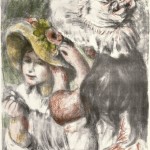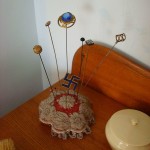 My latest foray into the research geekdom took me slightly out of the Regency Era, but since I love all kinds of old things, I decided to indulge in this new direction and share with you my latest discovery: hatpins.
My latest foray into the research geekdom took me slightly out of the Regency Era, but since I love all kinds of old things, I decided to indulge in this new direction and share with you my latest discovery: hatpins.
To quote Wikipedia: A hatpin is a decorative and functional pin for holding a hat to the head, usually by the hair. In Western Culture, a hatpin is almost solely a female item and is often worn in a pair.
The description made me smile since I can’t imagine anyone using a pin to fasten their hat to their head! Obviously, it attached to their hair 🙂
In as early as the 1400’s, proper, and, I might add, probably only fairly wealthy ladies, used pins to secure their wimples and veils onto their heads. By the early 1800’s, ladies used them to keep their hats in place, although many hats simply tied underneath the chin.
Hatpins ranged in length from six to twelve inches and were made from a variety of metals including brass, copper, sterling silver, gold, or gold or silver wash, and often had a decorated head. Naturally, they had to be made by hand, which made them hard to find. In England, demand caused importers to bring hatpins from France. Apparently Parliament became alarmed at the threat to the delicate balance between import and export, so they passed a law restricting the import of pins to January 1st and 2nd. Supposedly ladies saved their money all year to have enough to purchase. Some believe this is the source of the term “pin money.” Other sources claim pin money came from the beginning of each tax she supposedly used to pay for her pins. However, I have always held fast to the popular Regency belief that ladies used pin money to purchase pins used to fasten their gowns together, since buttons and hooks weren’t as common as modern people believe. Since the pins were made of metal, non-stainless steel, they eventually rusted and had to be replaced.
Regardless, hatpins remained a popular accessory into the 1920’s. Eventually in America, laws restricted the length of hat pins since they could be used as a deadly weapon so women had to cut them down to the maximum length. Hmm, that spawns all sorts of ideas, doesn’t it?
Eventually, hatpins became mass produced, making them more readily available to the poorer classes with very simple heads. Of course, the wealthy always had fun hatpin heads made from materials such as, according to the American Hatpin Society:
 Carnival glass, rhinestones, hand blown molded glass, micro mosaic, or hand painted or transferred porcelain like the Japanese Satsuma. There were also hatpins made with ivory, emeralds, stone, amber, tortoise shell, jet, celluloid and other plastics, mother of pearl, and coral.
Carnival glass, rhinestones, hand blown molded glass, micro mosaic, or hand painted or transferred porcelain like the Japanese Satsuma. There were also hatpins made with ivory, emeralds, stone, amber, tortoise shell, jet, celluloid and other plastics, mother of pearl, and coral.
Hatpins spanned many styles including Baroque, Etruscan Revival, Greek Revival, Egyptian Revival, Oriental influence, Arts and Crafts, Art Nouveau and even Art Deco, before waning around WW1 when metals became scarce and hats got smaller.
I was surprised (horrified?) to find in the picture to the right, a hatpin made in the shape of a swastika. I don’t know if of it’s a later manufacturing date worn by a Nazi supporter, or it is simply in this shape because it’s an ancient symbol–from India–I believe) that later became adopted by the Nazis. Regardless, the hatpins in this pincushion show a good variety of the many different styles of hatpins available. Today, hatpins are collectible items and there is an American Hatpin Society and The Hat Pin Society of Great Britain for modern enthusiasts.
Now that I know of their existence, I think I’ll have to write a scene in my next Regency historical romance novel where my heroine uses a hatpin to defend herself from a bad guy 🙂
